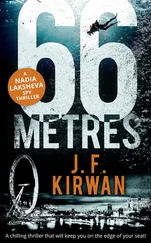But they got the gist. “Shit!” swore the gunner, who felt tricked by the pirates sneaking out at night. It took a while to get more out of the skipper than “Two boats, two boats” and “Please hurry up!” The pirates were shelling the bridge with bursts from their automatic weapons, and it seemed the ship had also taken some grenade hits. The men in skiffs had tried more than once to hook ladders onto the sides, and one of the freighter’s crew members was badly hurt. But so far, no pirates had gotten on board, and the captain was maneuvering his ship as well as he could to keep them off. “Please hurry up!”
The MV Sevastopol had grown into a fat cigar-shaped blip on the radar screen, matching its swelling dot on the horizon, and now had a clear wake.
Only in the last few hundred meters did the helicopter slow down. The same routine as before: door open, machine gun out. Although they weren’t taken by surprise, the men in the motorboats hesitated for a moment. The pirates had been so close, the prey almost in hand, just one more minute and … Even if you looked right into their faces, you’d never see disappointment. The skipper kept yelling over the radio, and on another channel, the Sveaborg kept asking what was happening, but the helicopter crew couldn’t care less about that. They had a single focus: the men in the boats, and what they did with their hands. The only one actually aiming with a weapon was their own gunner. The MV Sevastopol had stopped zigzagging and held a steady course, with one pirate boat just a few meters from her side, and a man still holding on to the long, hooked boarding ladder. The other boat was farther out. Five men in each—bare feet, skinny arms, T-shirts and shorts. A few moments to decide who was strong and who was weak. “Shoot! Shoot the monkeys!” shouted the Sevastopol ’s captain.
As if on cue, the two pirate boats revved to full throttle, spraying arcs behind their outboard engines. The Russian freighter remained on course, a tired old dinosaur, while both skiffs disappeared, leaving white streaks.
The pilot had already caught up. He could see how the men below shook as their boats hit the waves, even though their speed was child’s play for the helicopter. He felt a shameful wave of satisfaction, for in that instant, it was all just a game. An interlude between the pirates’ firing on defenseless people and the consequences that would bring. Now they were trying to escape, but escape was impossible.
“Give them a few rounds, see what happens.”
The gunner, who already had them in his sights, pulled the trigger. Twenty meters in front of the first boat, the water leapt up in white columns. The skiffs didn’t slow down. But the second boat, which had been following the first, made a wide arc and took off on its own. One helicopter, two boats; they’d certainly lose half their catch. The pilot continued straight ahead, a hundred feet up, just behind the remaining boat. The copilot updated the Sveaborg over the radio about what was happening. They needed no further orders or permission to pursue. It was obvious what they were facing, and what the people in the boats had done—piracy, no small thing; someone had been seriously wounded on a merchant ship. They were to be stopped at any cost.
“Fire again.”
The second volley hit just in front of the bow, so that water from the impact splashed into the boat. Some of the men ducked, as if the splashes were shrapnel. A chink in their armor, revealing that they were afraid. “We’ll give them a chance.” The pilot had dropped closer, less than a hundred meters between them now. Here the helicopter was at its most vulnerable, given that the pirates had more firepower: four or five Kalashnikovs and at least one rocket-propelled grenade. But these wouldn’t be an option now. The language of power was spoken through shiny technology, thundering rotors, and targeted firepower. Had anyone so much as reached for a weapon on the floor, the gunner would have instantly opened fire on the boat, without even an order from the commander on board. It would have been self-defense, clear and simple. And the men in the boat knew it. They might have been too high on khat or too afraid, but mostly they held their fire because of the balance of power. They had to accept their futility first.
One last chance, the pilot had said. The third volley sprayed from bow to stern next to the rail of the skiff. Impossible to shoot any closer without hurting someone, and none of the pirates wanted to risk a challenge. They just wanted to survive, and maybe get back home again. The boat stopped abruptly, and all five raised their hands. The helicopter pulled away and began circling. There was an intense burst of radio traffic, and they calculated their fuel reserves.
“How much time?” asked the pilot.
“Keep us at just below sixty knots, and we might have enough for an hour.” The HMS Sveaborg had been traveling at top speed for a while. Down below, the pirates had lowered their hands and sat bobbing in the boat, while the gunner kept them centered in the viewfinder of his TV camera. “Now they’re dumping the ladder,” he said. That was also part of the game. The Somalis were trying to get rid of evidence: they lowered the ladder into the sea while the gunner filmed.
“And there go the guns.”
Five nameless men in an empty boat somewhere in the Gulf of Aden.
The helicopter circled. They’d done this before. But then the radio crackled—an unexpected surprise.
“Snowman, Snowman, this is Russian Federation warship Admiral Chabanenko .”
“Shit,” swore the copilot. The Russians had a handful of warships in the region that didn’t belong to any task force. Instead, they ran their own show. Well-armed and aggressive, their approach to Africans with flip-flops and Kalashnikovs was: gloves off. The Russian destroyer Admiral Chabanenko was moving in like an arrow. And the fact that she could be heard over the VHF radio meant she couldn’t be very far off.
“Snowman, confirm you have the Somali pirates under your control.” The Russian combat controllers had a distinct accent, and their tone was never polite.
“Answer them,” said the pilot.
“You know what they’ll demand?”
“Answer them.”
The copilot replied to the Chabanenko , telling them where things stood. Then he radioed the Sveaborg : “Following the traffic?”
“We follow.”
“What’s happening?” asked Slunga, who’d been sitting silently in the cabin.
“We’ll explain later,” said the pilot.
“Just make sure to get a video of that damn boat down there,” the copilot reminded the gunner.
“Confirming your position,” said the Russians.
“They already see us on their radar,” the pilot explained to Slunga, and then added, resigned: “They’re taking over.”
“Mother, what are our orders?” radioed the copilot to the HMS Sveaborg.
“Wait,” said the Swedish combat controller.
It was obvious. The Russians had contacted their own military headquarters through other channels. Made their demands. Asserted their rights. Somewhere a Swedish admiral was sitting down with a lawyer, reading the fat paragraphs of rules and conventions: a Russian merchant ship attacked in international waters, a sailor seriously injured. Rights and wrongs—and politics. And keeping his hands clean. Chasing pirates was less about battle operations than about mastering these paragraphs.
The helicopter circled while the five men in the boat sat dazed and unsuspecting. A destroyer was on its way, doing at least forty knots. Somewhere in the Russian hull, weapons were being loaded and grenades readied.
“Snowman from Mother,” the Swedish ship radioed, “hand over the suspects.”
Читать дальше












